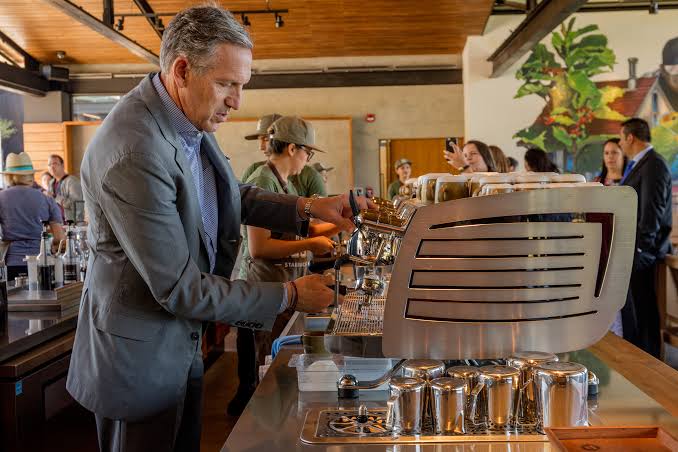Starbucks says it is eager to share the lessons it learns about adaptive farming with coffee growers around the globe.
星巴克表示,他們已經(jīng)迫不及待地想要同世界各地的咖啡種植者分享適應(yīng)性種植經(jīng)驗。
For big coffee companies buying from a variety of small suppliers, the argument goes,
就從各種小供應(yīng)商手里購買咖啡的大企業(yè)而言,他們的觀點是,
there’s no value in trying to gain a competitive advantage by hoarding trade secrets.
通過保守商業(yè)機密獲得競爭優(yōu)勢毫無價值可言。
Improving all coffee growers’ ability to survive climate change benefits the entire industry, Schultz says.
舒爾茨表示,提高所有咖啡種植者應(yīng)對氣候變化的能力將有利于整個行業(yè)的生存發(fā)展。
The company’s network of farmer support centers distributes free seeds, teaches new adaptation methods
該公司的農(nóng)民支持中心系統(tǒng)會免費分發(fā)種子,教授新的適應(yīng)方法,
and serves as a resource for farmers who are eager to learn how to adapt, regardless of whether they do business with Starbucks.
并為渴望學(xué)習(xí)適應(yīng)辦法的農(nóng)民,無論他們是否與星巴克存在商業(yè)往來,提供資源。
“It may be hard for people to understand why we are sharing all this information,” says Schultz.
“人們可能很難理解我們?yōu)槭裁匆窒硭羞@些信息,”舒爾茨說。
“If we don’t, there’s going to be tremendous adverse pressure on the coffee industry.”
“原因是,如果我們不這樣做,咖啡行業(yè)將面臨巨大的負面壓力。”
Starbucks will find plenty of interest in the results of its research.
星巴克對其研究結(jié)果產(chǎn)生濃厚的興趣。
Dwindling supply is a big problem for an industry that projects global coffee demand to double by 2050,
咖啡行業(yè)預(yù)計,在人口增長,亞洲,非洲等地鐘情咖啡的中產(chǎn)階級人群日益壯大等因素的推動下,
driven by population increases and a growing coffee-addicted middle class in Asia, Africa and elsewhere.
到2050年,全球咖啡需求將會翻倍,對這樣一個行業(yè)而言,供應(yīng)縮水無疑是個大問題。

As a result, nearly every major coffee retailer is paying closer attention to the source of its beans than ever before.
正因為如此,如今,幾乎所有大型咖啡零售商都比以往任何時候更加關(guān)注其咖啡豆的來源。
The companies whose products touch nearly every American household—
產(chǎn)品觸及到幾乎每個美國家庭的那些企業(yè)——
think Starbucks, Keurig Green Mountain, J.M.Smucker and countless others—
想想星巴克、科瑞格綠山、盛美家以及無數(shù)其他咖啡公司你就知道了——
have installed themselves at the ground level of the coffee supply chain in a way unimaginable even a generation ago.
紛紛已經(jīng)在咖啡供應(yīng)鏈底端扎穩(wěn)了腳跟,而他們采用的方式,即便放到上一代人那個年代,都是難以想象的。
Small farmers now interact directly with big-name coffee retailers after years of dealing with local traders only.
多年以來,種植咖啡的小農(nóng)戶只與當(dāng)?shù)厣特溩錾猓缃瘢麄円呀?jīng)開始直接同知名咖啡零售商做生意。
“In the beginning, it was scary,” says Sara Bogantes Vargas,
談及農(nóng)戶們看到星巴克的農(nóng)場就在自家后院時的反應(yīng),
a regional coordinator for the industry-funded World Coffee Research (WCR),
行業(yè)贊助的世界咖啡研究項目(WCR)的地區(qū)協(xié)調(diào)人莎拉·博甘蒂斯·瓦格斯說到:
of the farmers’ reaction to seeing the Starbucks farm in their backyard.
“剛開始,他們還覺得挺嚇人的,”
But Bogantes Vargas says the planters quickly came to welcome the industry’s help.
但是,博甘蒂斯·瓦格斯說,農(nóng)戶們很快就開始歡迎行業(yè)對他們的幫助了。
WCR, for which Bogantes Vargas travels around Central America to meet with farmers,
WCR——就是因為該項目,博甘蒂斯·瓦格斯才奔波于中亞各地見當(dāng)?shù)氐霓r(nóng)戶——
is a consortium supported by dozens of major coffee retailers, distributors and exporters.
是一個由數(shù)十家主要的咖啡零售商、分銷商及出口商聯(lián)合經(jīng)營的一個項目。
The institute pumps millions of dollars into lab research and coffee field trials every year.
該研究所每年注入實驗室研究和咖啡田田野試驗的投資高達數(shù)百萬美元。
The scale is enormous.
其研究規(guī)模十分龐大。
WCR’s $18 million coffee-monitoring program, for example, covers 1,100 farms in 20 countries.
其耗資1800萬美元的咖啡監(jiān)控項目就覆蓋了20個國家的1100個農(nóng)場。
It includes on-the-ground training for farmers, technical assistance throughout the trials and supply-chain analysis.
涵蓋了對農(nóng)民進行實地培訓(xùn)、試驗過程中的技術(shù)援助和供應(yīng)鏈分析等諸多方面。
In each of those farms, located from Peru to Kenya,
從秘魯?shù)娇夏醽喌拿恳粋€農(nóng)場,
WCR has taken over a small portion of farmers’ land for an experiment testing coffee varieties and various adaptive farming methods.
WCR都會從農(nóng)民的土地中騰出一小塊,用于試驗咖啡品種和各種適應(yīng)性種植方法。
WCR and partner agronomists plant different coffee hybrids, take soil samples and test techniques like planting trees for shade.
WCR會與合作的農(nóng)學(xué)家種植各種咖啡雜交品種,采集土壤樣本,測試種植樹木遮蔭等技術(shù)。
譯文由可可原創(chuàng),僅供學(xué)習(xí)交流使用,未經(jīng)許可請勿轉(zhuǎn)載。













